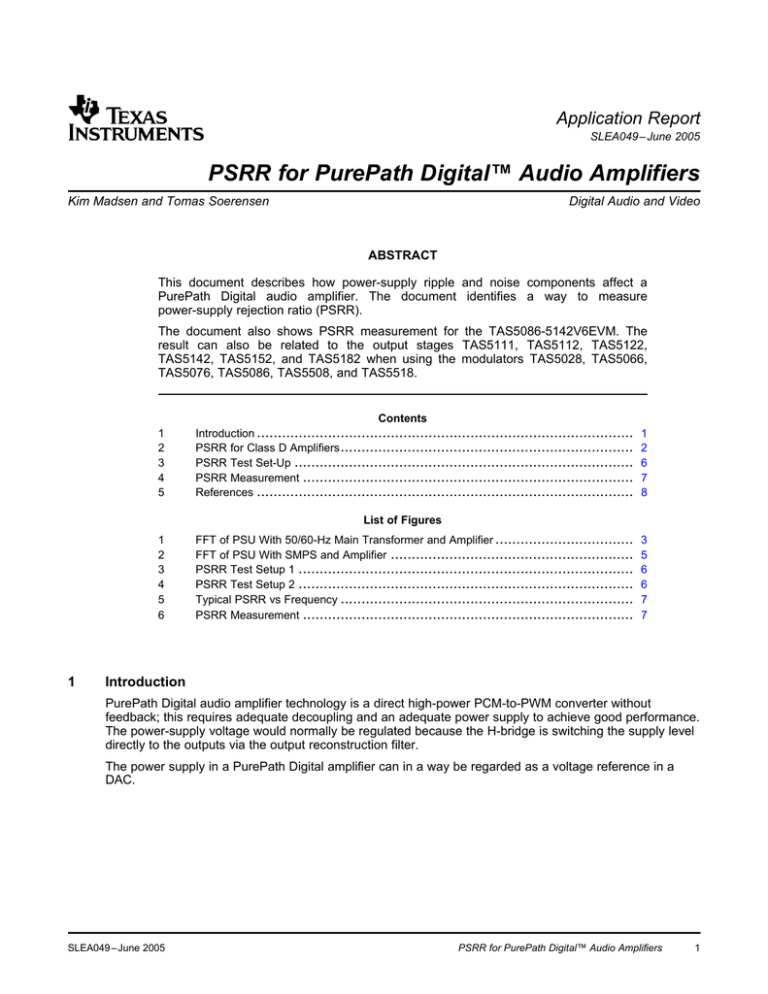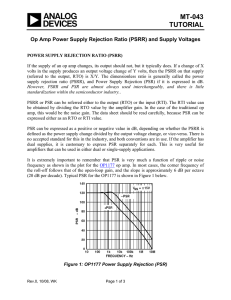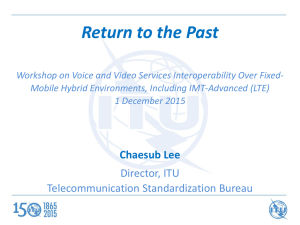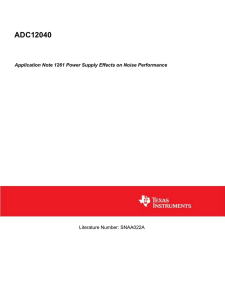PSRR for Purepath Digital Audio Amplifiers
advertisement

Application Report SLEA049 – June 2005 PSRR for PurePath Digital™ Audio Amplifiers Kim Madsen and Tomas Soerensen ..................................................................... Digital Audio and Video ABSTRACT This document describes how power-supply ripple and noise components affect a PurePath Digital audio amplifier. The document identifies a way to measure power-supply rejection ratio (PSRR). The document also shows PSRR measurement for the TAS5086-5142V6EVM. The result can also be related to the output stages TAS5111, TAS5112, TAS5122, TAS5142, TAS5152, and TAS5182 when using the modulators TAS5028, TAS5066, TAS5076, TAS5086, TAS5508, and TAS5518. 1 2 3 4 5 Contents Introduction .......................................................................................... PSRR for Class D Amplifiers ...................................................................... PSRR Test Set-Up ................................................................................. PSRR Measurement ............................................................................... References .......................................................................................... 1 2 6 7 8 List of Figures 1 2 3 4 5 6 1 FFT of PSU With 50/60-Hz Main Transformer and Amplifier ................................. FFT of PSU With SMPS and Amplifier .......................................................... PSRR Test Setup 1 ................................................................................ PSRR Test Setup 2 ................................................................................ Typical PSRR vs Frequency ...................................................................... PSRR Measurement ............................................................................... 3 5 6 6 7 7 Introduction PurePath Digital audio amplifier technology is a direct high-power PCM-to-PWM converter without feedback; this requires adequate decoupling and an adequate power supply to achieve good performance. The power-supply voltage would normally be regulated because the H-bridge is switching the supply level directly to the outputs via the output reconstruction filter. The power supply in a PurePath Digital amplifier can in a way be regarded as a voltage reference in a DAC. SLEA049 – June 2005 PSRR for PurePath Digital™ Audio Amplifiers 1 www.ti.com PSRR for Class D Amplifiers 2 PSRR for Class D Amplifiers Power-supply rejection ratio (PSRR) is well known for normal class-A/B amplifiers and can be used also for analog-input class-D amplifiers with feedback. PurePath Digital amplifiers do not use feedback; the PSRR term is therefore different. The PurePath Digital amplifier switches the power-supply voltage directly into the output filter. A simplified expression of the output signal is: VOUT(t) = VPSU(t) × Duty(t) where VPSU(t) is the power-supply voltage, and Duty(t) is the duty cycle of the PWM signal as function of time. For a full-scale 1-kHz output signal, Duty(t) is a sine wave with an amplitude of 1. VPSU(t) can be split into a dc value and an ac signal, representing the ripple and noise voltage. If a 50/60-Hz main transformer is used, the rectified output is a dc voltage with a 100/120-Hz ripple voltage and the harmonics thereof. Then, if a full-scale, 1-kHz signal is output, an error coming from the multiplying term shown in the foregoing equation produces sidebands 100/120 Hz from the fundamental tone. This is illustrated in Figure 1. 2 PSRR for PurePath Digital™ Audio Amplifiers SLEA049 – June 2005 www.ti.com PSRR for Class D Amplifiers Power-Supply DC Level 100-Hz Ripple Voltage With Harmonics 0 Hz 1 kHz 2 kHz 3 kHz Power-Supply Voltage FFT 1-kHz Tone DC-Offset The 100-Hz Ripple Voltage on the Power Supply Multiplies With the 1-kHz Tone and Gives 100-Hz Sidebands The 100-Hz Ripple Voltage on the Power Supply is Feedthrough with Approx. 60-dB Attenuation 2nd Harmonic 3rd Harmonic 0 Hz 1 kHz 2 kHz 3 kHz Output Signal FFT M0025-01 Figure 1. FFT of PSU With 50/60-Hz Main Transformer and Amplifier Figure 1 shows the FFT of the voltage and the FFT of the output signal. The FFT of the power-supply voltage consists of a dc term, a 100-Hz ripple voltage with higher harmonics coming from the rectification. SLEA049 – June 2005 PSRR for PurePath Digital™ Audio Amplifiers 3 www.ti.com PSRR for Class D Amplifiers The output signal FFT shows several tones. • The audio 1-kHz signal • Harmonic distortion of the 1-kHz signal (second and third harmonics shown) • Sidebands to the 1-kHz tone (and to the harmonics) coming from the multiplication of the 100-Hz ripple voltage and the 1-kHz audio signal and its harmonics • Feedthrough of the 100-Hz signal, with a approximately 60-dB attenuation • Output dc-offset voltage The noise is not illustrated, but excessive noise on the power-supply voltage also is multiplied on the audio signal. The tones shown are not to scale, but are shown for explanation only. If a switch-mode power supply (SMPS) is used, there is no 100/120 Hz ripple voltage, but there can be a switching-frequency ripple voltage. This is normally well above the audio band and low-amplitude (less than 100 mV); therefore, no audible tones are produced. Figure 2 shows the FFT. A point to be aware of regarding the SMPS is to use a good low-pass filter on the voltage reference for the regulation so that the short-term stability is good. A second-order filter with a cutoff frequency below 10 Hz is normally adequate. An example for an adequate reference voltage is the Texas Instruments shunt regulator TL431 with the addition of the low-pass filter. The TL431 family is widely used in SMPS designs. 4 PSRR for PurePath Digital™ Audio Amplifiers SLEA049 – June 2005 www.ti.com PSRR for Class D Amplifiers Power-Supply DC Level 0 Hz 1 kHz 2 kHz 3 kHz Switch Mode Power-Supply Voltage FFT 1-kHz Tone 2nd Harmonic DC-offset 3rd Harmonic 0 Hz 1 kHz 2 kHz 3 kHz FFT of the Output Signal With SMPS M0025-02 Figure 2. FFT of PSU With SMPS and Amplifier SLEA049 – June 2005 PSRR for PurePath Digital™ Audio Amplifiers 5 www.ti.com PSRR Test Set-Up 3 PSRR Test Set-Up PSRR can be measured in different ways. One uses standard analog generators and RMS voltmeters, and another could be to use an audio analyzer and an external amplifier. The power supply is fed to the device under test (DUT) through a big resistor or inductor. This is to provide high ac impedance to the power supply. The inductor or resistor must have at least 10× higher impedance than the signal generator. The ac signal is then injected into the supply line through a capacitor. The test setup is shown in Figure 3. 47 mF + Power Amp 2W 20 W + PSU + + + DUT 2 ´ 6.8 mF – 6W – S0076-01 Figure 3. PSRR Test Setup 1 A different way is to use a transformer to inject the ac signal. A transformer is placed in series with the power supply. This transformer must be able to handle the dc current drawn by the DUT. A capacitor is placed in parallel with the power supply to give an ac-signal path to GND. The ac signal is then injected into the supply line via the transformer. The test setup is shown in Figure 4. AC Generator Device Under Test Power Supply RLOAD S0077-01 Figure 4. PSRR Test Setup 2 Running the amplifier at 50% duty cycle (mute) makes it possible to measure the PSRR. This is calculated as: V (f) PSRR(f) 20 log OUT V INJECT(f) Typical PSRR with the amplifier muted is shown in Figure 5. 6 PSRR for PurePath Digital™ Audio Amplifiers SLEA049 – June 2005 www.ti.com PSRR Measurement PSRR − Power Supply Rejection Ratio − dB 0 −10 −20 −30 −40 −50 −60 −70 −80 0.01 0.1 1 10 f − Frequency − kHz G001 Figure 5. Typical PSRR vs Frequency The PSRR is approximately –60 dB up to approximately 800 Hz, and then it rises to –35 dB at 20 kHz. The rise at higher frequencies is due to non-ideal behavior of the output stage and the parasitic capacitors and inductors. The normal decoupling of the power-supply voltage provides a filter whereby the noise injected into the power-supply line is filtered at higher frequencies. Therefore, the rise at high frequencies does not contribute to a perceived higher noise at the output. 4 PSRR Measurement PSRR has been measured using the TAS5086-5142V6EVM and Audio Precision analyzer as shown in Figure 6. PSRR − Power-Supply Rejection Ratio − dBV 10 0 −10 −20 −30 −40 −50 −60 −70 −80 −90 −100 0.1 1 10 20 f − Frequency − kHz G002 Figure 6. PSRR Measurement SLEA049 – June 2005 PSRR for PurePath Digital™ Audio Amplifiers 7 www.ti.com References The PSRR is approximately –58 dB from 20 Hz to 3 kHz. It then rises to –30 dB at 20 kHz. The rise at higher frequencies is due to non-ideal behavior of the output stage and parasitic capacitors and inductors. Normal decoupling of the power-supply voltage provides a filter whereby the noise injected into the power-supply line is filtered at higher frequencies. Therefore, the rise at high frequencies does not contribute to a perceived higher noise on the output, due to the total system noise response. 5 References 1. System Design Considerations for True Digital Audio Power Amplifiers (SLAA117) 2. Digital Audio Measurements (SLAA114) PurePath Digital is a trademark of Texas Instruments. 8 PSRR for PurePath Digital™ Audio Amplifiers SLEA049 – June 2005 IMPORTANT NOTICE Texas Instruments Incorporated and its subsidiaries (TI) reserve the right to make corrections, modifications, enhancements, improvements, and other changes to its products and services at any time and to discontinue any product or service without notice. Customers should obtain the latest relevant information before placing orders and should verify that such information is current and complete. All products are sold subject to TI’s terms and conditions of sale supplied at the time of order acknowledgment. TI warrants performance of its hardware products to the specifications applicable at the time of sale in accordance with TI’s standard warranty. Testing and other quality control techniques are used to the extent TI deems necessary to support this warranty. Except where mandated by government requirements, testing of all parameters of each product is not necessarily performed. TI assumes no liability for applications assistance or customer product design. Customers are responsible for their products and applications using TI components. To minimize the risks associated with customer products and applications, customers should provide adequate design and operating safeguards. TI does not warrant or represent that any license, either express or implied, is granted under any TI patent right, copyright, mask work right, or other TI intellectual property right relating to any combination, machine, or process in which TI products or services are used. Information published by TI regarding third-party products or services does not constitute a license from TI to use such products or services or a warranty or endorsement thereof. Use of such information may require a license from a third party under the patents or other intellectual property of the third party, or a license from TI under the patents or other intellectual property of TI. Reproduction of information in TI data books or data sheets is permissible only if reproduction is without alteration and is accompanied by all associated warranties, conditions, limitations, and notices. Reproduction of this information with alteration is an unfair and deceptive business practice. TI is not responsible or liable for such altered documentation. Resale of TI products or services with statements different from or beyond the parameters stated by TI for that product or service voids all express and any implied warranties for the associated TI product or service and is an unfair and deceptive business practice. TI is not responsible or liable for any such statements. Following are URLs where you can obtain information on other Texas Instruments products and application solutions: Products Applications Amplifiers amplifier.ti.com Audio www.ti.com/audio Data Converters dataconverter.ti.com Automotive www.ti.com/automotive DSP dsp.ti.com Broadband www.ti.com/broadband Interface interface.ti.com Digital Control www.ti.com/digitalcontrol Logic logic.ti.com Military www.ti.com/military Power Mgmt power.ti.com Optical Networking www.ti.com/opticalnetwork Microcontrollers microcontroller.ti.com Security www.ti.com/security Telephony www.ti.com/telephony Video & Imaging www.ti.com/video Wireless www.ti.com/wireless Mailing Address: Texas Instruments Post Office Box 655303 Dallas, Texas 75265 Copyright 2005, Texas Instruments Incorporated



